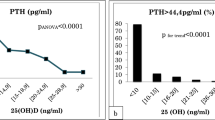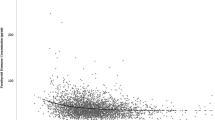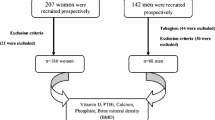Abstract
Summary
We assume that 25(OH)D level >50 nmol/l is necessary for adequate parathyroid hormone (PTH) suppression in our population. The epidemiology of vitamin D status in Bulgarian population shows deficiency in 21.3 %, insufficiency in 54.5 % and sufficiency in 24.2 %. The mean level of 25(ОН)D for the Bulgarian population is 38.75 nmol/l (95 % CI, 38.00–39.49).
Purpose
The aim of the present study was to investigate the vitamin D levels in Bulgaria and the prevalence of vitamin D deficiency depending on gender and age, as well as to define population-specific 25(OH)D sufficiency thresholds through the relationship with PTH.
Material and method
This cross-sectional study was conducted in January–February 2012 and included 2,032 subjects in 12 regions—1,076 women (53 %) and 956 men (47 %), mean age 49.30 ± 14.75 years (20–80 years), divided into three age groups: young (20–44 years, n = 894), middle-aged (45–59 years, n = 534), and elderly (≥60 years, n = 604). 25(OH)D and PTH were measured in all subjects.
Results
The mean level of 25(ОН)D was 38.75 nmol/l (95 % CI, 38.00–39.49). The men had significantly higher 25(ОН)D levels in comparison to women (41.51 nmol/l (95 % CI, 40.45–42.56) vs.36.29 nmol/l (95 % CI, 35.27–37.32), p < 0.05). We did not find significant differences in the 25(ОН)D levels between the three age groups. The prevalence of vitamin D deficiency was 21.3 %; insufficiency, 54.5 %; and sufficiency, 24.2 %. Deficiency was more prevalent in women (26.9 %) than in men (15.1 %), p < 0.001. PTH started to rise over the upper limit of the reference range at mean 25(OH)D 50 nmol/l. We assume that levels over 50 nmol/l are necessary for adequate PTH suppression.
Conclusions
The status of vitamin D in our country is worrisome, and it is largely underestimated. The defining of a vitamin D sufficiency levels may help the devising of adequate strategies for prevention and treatment in clinical practice.


Similar content being viewed by others
References
Standing committee on the Scientific Evaluation of Dietary Intakes FaNBIoM (1997) Dietary reference intakes for calcium, phosphorus, magnesium, vitamin D and fluoride. National Academy, Washington, DC, pp 250–287
Holick MF (2002) Vitamin D: the underappreciated D-lightful hormone that is important for skeletal and cellular health. Curr Opin Endocrinol Diabetes Obes 9:87–98
Dawson-Hughes B, Heaney RP, Holick MF et al (2005) Estimates of optimal vitamin D status. Osteoporosis Int 16:713–716
Lips P (2001) Vitamin D deficiency and secondary hyperparathyroidism in the elderly: consequences for bone loss and fractures and therapeutic implications. Endocr Rev 22:477–501
Holick MF, Binkley NC, Bischoff-Ferrari HA et al (2011) Evaluation, treatment, and prevention of vitamin D deficiency: Еndocrine Society Clinical Practice Guideline. J Clin Endocrinol Metab 96:1911–1930
Lips P, et al (2005) ASBMR, Nashville, TN,USA
Mithal A, Wahl DA, Bonjour J-P et al (2009) On behalf of the IOF Committee of Scientific Advisors (CSA) Nutrition Working Group. Global vitamin D status and determinants of hypovitaminosis D. Osteoporosis Int 20:1807–1820
WahlD A, Cooper C, Ebeling PR, Eggersdorfer M, Hilger J, Hoffmann K, Josse R, Kanis JA, Mithal A, Pierroz DD et al (2012) A global representation of vitamin D status in healthy populations. Arch Osteoporos. doi:10.1007/s11657-012-0093-0
De Groot LCPGM, van Staveren WA, Dirren H. Hautvast JGAJ (1996) eds. SENECA. Nutrition and the elderly in Europe. Follow-up study and longitudinal analysis. Eur J Clin Nutr;50 (suppl 2):1–127
National Statistical Institute (2011) 17th National Sensus on the population in Bulgaria, 1–28 February (http://censusresults.nsi.bg/Census/Reports/2/2/R1.aspx)
FDA/CDER/CVM/DHHS (2001) Guidance for industry: bioanalytical method validation. May
Bischoff-Ferrari HA (2012) Vitamin D–why does it matter ?—defining vitamin D deficiency and its prevalence. Scand J Clin Lab Investig 72(Suppl 243):3–6
Tylavsky FA, Cheng S, Lyytikainen A et al (2006) Strategies to improve vitamin D status in northern European children: exploring the merits of vitamin D fortification and supplementation. J Nutr 136:1130–1134
Burnand B, Sloutskis D, Gianoli F et al (1992) Serum 25-hydroxyvitamin D: distribution and determinants in the Swiss population. Am J Clin Nutr 56:537–542
Norman A (2011) Vitamin D nutrition is at a crossroads. Public Health Nutrition 14:750–751
Souberbielle JC, Body JJ, Lappe J et al (2010) Vitamin D and musculoskeletal health, cardiovascular disease, autoimmunity and cancer: recommendations for clinical practice. Autoimmun Rev 9:709–715
Dawson-Hughes B, Mithal A, Bonjour JP, Boonen S, Burckhardt P, Fuleihan GE, Josse RG, Lips P, Morales-Torres J, Yoshimura N (2010) IOF position statement: vitamin D recommendations for older adults. Osteoporos Int 21:1151–1154
Ross C, Manson JE, Abrams S et al (2011) The 2011 report on dietary reference intakes for calcium and vitamin D from the Institute of Medicine: what clinicians need to know. J Clin Endocrinol Metab 96:53–58
Institute of Medicine (2011) Dietary reference intakes for calcium and vitamin D. National Academies, Washington, DC
van Dam RM, Snijder MB, Dekker JM et al (2007) Potentially modifiable determinants of vitamin D status in an older population in the Netherlands: the Hoom Study. Am J Clin Nutr 85:755–761
Holick MF, Matsuoka LY, Wortsman J (1989) Age, vitamin D and solar ultraviolent. Lancet 2:1104–1105
McKenna MJ (1992) Differences in vitamin D status between countries in young adults and the elderly. Am J Med 93:69–77
Looker AC, Pfeiffer CM, Lacher DA et al (2008) Serum 25-hydroxyvitamin D status of the US population: 1988–1994 compared with 2000–2004. Am J Clin Nutr 88:1519–1527
van Schoor NM, Lips Р (2011) Worldwide vitamin D status. Best Pract Res Clin Endocrinol Metab 25:671–680
Acknowledgments
The authors thank the endocrinologists, who provided local support: Е. Dimitrova (Vidin), J. Stoyanova (Мontana), V. Jotova (Тroyan), R. Bobeva, А. Мomtcheva, V. Sabev (Sliven), J. Gerenova (Stara Zagora), P. Velkova, D. Jekova (Dobritch), B. Savova, А. Кisselova (Russe), V. Маrgaritov (Byala), Т. Коtselova (Blagoevgrad), and К. Аnastassov (Sandansky); technical support: А. Popov, G. Мichaylov, К. Pantcheva, G. Аntalavitcheva, Т. Кornilova, S. Мichaylova, B. Petrovska, Е. Blajeva, and А. Palmarev. Sponsors from the Pharmaceutical industry: Aquachim, Roche-Bulgaria, Eli Lilly/Boehringer Ingelheim, Amgen, MSD, Merck Serono, Servier, Novartis, and Berlin-Chemie are also acknowledged.
Conflicts of interest
None.
Author information
Authors and Affiliations
Corresponding author
Rights and permissions
About this article
Cite this article
Borissova, AM., Shinkov, A., Vlahov, J. et al. Vitamin D status in Bulgaria—winter data. Arch Osteoporos 8, 133 (2013). https://doi.org/10.1007/s11657-013-0133-4
Received:
Accepted:
Published:
DOI: https://doi.org/10.1007/s11657-013-0133-4




